
Wine Culture and Information since 2002 - Volume 22
 Wine Culture and Information since 2002 - Volume 22 |
|
Contrasts of Garda Classico Chiaretto and Cerasuolo d'AbruzzoTwo of the main rosé wines of Italy compared in the glasses of this month's tasting by contrast. Two very different territories and two equally different wines |
|
Rosé wines have been considered for a long time, probably too long, so to speak, “lesser wines”, placed between whites and reds, therefore in a position that many considered alien in the world of wine. For the sake of clarity, it must be said that – in fact – in the past, this category of wines was not truly considered by the producers themselves, often they were, with due exceptions, “lesser wines” to which they dedicated wine making practices of no significant or low quality. Therefore, the bad reputation that in the past was associated with rosé wines had a concrete foundation due to productions that were not really of quality. Wines often produced from the “bleeding” of quality red wines, not least, produced with grapes that were not exactly significant or from the second pressing of grapes already deprived of the best must and destined to the more profitable productions. Of course, this is a generalization, as even in the past quality rosé wines were produced, however they certainly were a minority compared to the total of the category. Fortunately, those times have gone and consigned to oblivion and today the scenario of rosé wines is hugely different and, at last, the producers are now dedicating, for years now, the attention and care these wines deserve. It must be said, in fact, rosé wines are not only a category with authentic enological dignity, but, in particular, they have an extraordinary versatility at the table, allowing a wide variety of possibilities for the pairing with food. Italy has an interesting production of rosé wines, often provided for by the disciplinaries of many Denominazione d'Origine Controllata areas. In some cases – as for Cerasuolo d'Abruzzo, one of the two wines of this month's tasting – have been established specific denominations and which only provide for the rosé style. In others, as in the case of Garda Classico Chiaretto – the second wine we will pour into the glasses of this month's tasting – rosé wines are included in denominations that provide for different styles.
|
|
In the suggestive scenery overlooking the largest lake in Italy is produced one of the country's best-known rosé wines. Not only rosé wines – it must be said – as in the area of Lake Garda there are several Denominazione d'Origine COntrollata wine areas (Denomination of Controlled Origin), among them, there is of course Garda DOC. In fact, Garda Classico Chiaretto, the first wine we will examine in this month's tasting by contrast, belongs to this denomination. The undisputed glory of Garda DOC red and rosé wines – and therefore also of Chiaretto – is Groppello, a red grape variety native to these lands, capable of making wines of great interest and personality. Grape producing compact and closed clusters resembling “pine cones”, it gets its name from the dialectal term groppo, that is “knot”, therefore emphasizing its tight and closed appearance. In this regard, it should be noted that Groppello is actually a family of varieties attributable to this name and of which the most common and significant member, in enological terms, is the so-called Groppello Gentile, the most widespread and used one for the production of Garda DOC wines. As for the production of this rosé wine, in addition to Gentile, the production disciplinary also permits the use of Groppello Santo Stefano and Mocasina types. Groppello, as already mentioned, is a variety capable of giving a strong personality to its wines, a characteristic we also find in Garda Classico Chiaretto. In this regard, it should be noted the production disciplinary provides, in addition to the use of the three Groppello grapes mentioned above and which must be present for at least 30%, also the varieties Marzemino, Sangiovese and Barbera, all present for a minimum of 5% each. Therefore, because of this, Groppello can be present in Garda Classico Chiaretto for a maximum of 85%. In this regard, it should be noted that producers often tend to use dominant quantities of Groppello, a choice that – evidently – contributes to the strong personality of this wine, capable of distinguishing itself to the nose for its pleasing spicy aromas, with clear reminiscences of flowers and red fruits.
|
||||
|
Cerasuolo d'Abruzzo is a very different wine and – above all – originating from very different lands and scenarios, a wine of primary importance in this region and, not least, among the most famous and celebrated rosés in Italy. The foundation of Abruzzo enology is made by Trebbiano d'Abruzzo and Montepulciano varieties, undisputed protagonists of the vineyards of this region. In particular, Montepulciano is the variety with which Cerasuolo d'Abruzzo is produced, one of the wines of our tasting by contrast. A versatile grape with an extraordinary personality, Montepulciano is capable of making powerful and rich red wines, not least elegant and pleasing rosé wines, such as Cerasuolo d'Abruzzo. This important rosé wine is typically an expression of red pulp fruits and flowers, with a pleasing acidity, it is characterized by a good structure and allows a versatile and rich use in food and wine pairing. As is often the case with Denominazione d'Origine Controllata Italian wines, the main variety – Montepulciano, in the case of Cerasuolo d'Abruzzo – must be present for at least 85% and the remainder can be made from varieties allowed for cultivation in the Abruzzo region. As a consequence, according to the production disciplinary, Cerasuolo d'Abruzzo may not be produced with 100% Montepulciano, although most of producers choose to use this variety exclusively. Cerasuolo d'Abruzzo is characterized by lively and pleasing aromas of red pulp fruits and flowers, in the mouth has a pleasing crispness with a well balanced acidity, often having a good structure. In most cases, Cerasuolo d'Abruzzo is vinified and aged in inert containers, an appropriate choice for this style in order to preserve and ensure the maximum expression of both aromas and the characteristic gustatory crispness.
|
We can now begin this month's tasting by contrast and proceed – first of all – with the choice of the two wines we will pour into the glasses. It will not be difficult to find the bottles of this month's tasting as both are widely and easily available in wine shops. As for Garda Classico Chiaretto, we will choose a bottle produced with the maximum allowed quantity of Groppello – therefore, 85% – and the remaining part of the other varieties allowed for the production of this wine. Also in the choice of Cerasuolo d'Abruzzo, we will pay attention to the frequent 85% often allowed for Denomination of Controlled Origin wines. Montepulciano – in fact – can be present in this wine for a minimum of 85%, therefore we will make sure the wine we will choose is produced exclusively with this grape. For the sake of clarity, it must be said most of the Abruzzo producers use, for their Cerasuolo d'Abruzzo, Montepulciano only, therefore the choice is not difficult. In both wines, however, we will make sure the vinification is carried out in inert containers – preferably the stainless steel tank – and belonging to the most recent harvest. Garda Classico Chiaretto and Cerasuolo d'Abruzzo are poured into tasting glasses at a temperature of 12 °C (54 °F). Let's pour the two wines of this month's tasting by contrast in their respective glasses and begin the sensorial evaluation by examining the appearance. In this regard it should be noted the color of rosé wines is strongly determined by the way in which they are produced, in particular the coloring power of the grapes and, even more important, the maceration time of the must with the skins. For this reason, giving a reliable reference makes little sense because of this production choices, while noting – moreover – the disciplinary production does not provide for maceration times, a factor depending on the choice of the producer. However, in order to provide a reference indication, it can be said Garda Classico Chiaretto is generally characterized by a lighter color than Cerasuolo d'Abruzzo, however – because of the maceration times chosen by the respective producers – the exact opposite could also be true. In both wines, however, we will observe a bright and intense cherry pink color, sometimes tending to salmon or onion skin color, especially in Cerasuolo d'Abruzzo. Transparency, in both cases, is moderate, still allowing the vision of the object placed in contrast between the glass and the white surface. Garda Classico Chiaretto and Cerasuolo d'Abruzzo express very different aromas from the glass, although both are clearly characterized by red pulp fruits and flowers. Responsible for these differences, in addition to the grapes, are also the territories where these wines are produced in. The olfactory profile of Garda Classico Chiaretto is mainly determined by Groppello, a variety often giving its wines a somewhat spicy character in which can be recognized white pepper. The dominant qualities of Garda Classico Chiaretto are however represented by floral sensations, in particular rose, as well as red pulp fruits, such as cherry, raspberry and strawberry. In some cases, it can also be perceived aromas of aromatic herbs and, in particular, juniper berry. The olfactory profile of Cerasuolo d'Abruzzo is strongly characterized by aromas of red and sometimes even dark pulp fruits, in particular, cherry, blueberry, blackberry, plum and raspberry. In this wine we can also perceive sensations directly recalling flowers, in particular, violet and cyclamen. Let's resume our tasting by contrast and proceed with the sensorial analysis of the olfactory profiles of the two wines, starting – as in the previous phase – with the examination of Garda Classico Chiaretto. Let's hold the glass in vertical position and, without swirling, let's do the first smell in order to evaluate the opening of the wine. From the glass can be perceived clear and pleasing aromas of cherry, raspberry and strawberry followed by a floral aroma in which can be recognized rose. Now let's swirl the glass – an operation favoring the oxygenation of the wine, therefore the development of the remaining olfactory qualities – and let's do the second smell. Garda Classico Chiaretto is completed with plum and peach, often followed by a pleasing hint of white pepper and juniper. The opening of Cerasuolo d'Abruzzo, evaluated by keeping the glass in vertical position and without swirling, is characterized by a decidedly fruity profile made of cherry, blackberry and raspberry as well as violet. After having swirled the glass, the profile of the wine from Abruzzo is completed with strawberry, cyclamen, blueberry, pomegranate and plum. Let's move on and pass to the evaluation of the gustatory profiles of Garda Classico Chiaretto and Cerasuolo d'Abruzzo. The first wine we will examine is, like in the previous phases, the one belonging to Garda denomination. Let's take a sip and evaluate the attack of the wine, that is the primary and identifying sensations distinguishing the gustatory profile of a wine. Garda Classico Chiaretto has a crisp attack of pleasing acidity, a good structure, however not impressive, reaching a good balance thanks to the effect of alcohol. In the mouth are perceived flavors of cherry, raspberry and strawberry, confirming the good correspondence to the nose. Let's now take a sip of the Cerasuolo d'Abruzzo and evaluate its attack. The wine from Abruzzo has a pleasing crispness, with good acidity and a fuller structure than Garda Classico Chiaretto. Moreover, in this wine is perceived a more intense roundness and the alcohol by volume is often higher. In the mouth are perceived flavors of cherry, blackberry, raspberry and blueberry, therefore having a good correspondence to the nose. Let's conclude this month's tasting by contrast with the evaluation of the final impressions the two wines leave in the mouth after swallowing, in particular, the taste-olfactory persistence, a fundamental factor for the quality of a wine. The finish of Garda Classico Chiaretto is persistent, leaving in the mouth the pleasing crispness given by acidity as well as clean flavors of cherry, raspberry and strawberry. We also continue to perceive the sensation of moderate structure, certainly not powerful. The finish of Cerasuolo d'Abruzzo is persistent and, also in this case, in the mouth is perceived the pleasing crispness of acidity, well supported by the sensation of good structure and roundness, both being more intense than Garda Classico Chiaretto. In the mouth can be still perceived the flavors of cherry, blackberry and raspberry. Let's now place the two glasses next to each other and repeat the evaluation of the olfactory profiles, first Garda Classico Chiaretto, then Cerasuolo d'Abruzzo. The differences are clear and evident, marked, in particular, by the personality Groppello grape gives to Garda Classico Chiaretto with its spicy note reminiscent of white pepper and, often, juniper.
|
||||||||
Wines of the Month |
|
|
|
Score legend Prices are to be considered as indicative. Prices may vary according to the country or the shop where wines are bought |
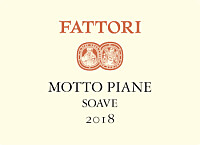
|
|
Soave Motto Piane 2018 |
|
| Fattori (Veneto, Italy) | |
 Garganega Garganega | |
| Price: € 11.80 | Score: |
 Intense straw yellow and nuances of straw yellow, very transparent. Intense straw yellow and nuances of straw yellow, very transparent. Intense, clean, pleasing, refined and elegant, starts with hints of
apple, plum and medlar followed by aromas of pear, peach, citrus fruits,
hawthorn, broom, honey, linden, sage and almond. Intense, clean, pleasing, refined and elegant, starts with hints of
apple, plum and medlar followed by aromas of pear, peach, citrus fruits,
hawthorn, broom, honey, linden, sage and almond.
 Crisp attack and however balanced by alcohol, good body, intense
flavors, pleasing roundness. Crisp attack and however balanced by alcohol, good body, intense
flavors, pleasing roundness.
 Persistent finish with flavors of apple, plum and medlar. Persistent finish with flavors of apple, plum and medlar. Made from Garganega grapes dried for 30 days, aged in steel tanks
and cask. Made from Garganega grapes dried for 30 days, aged in steel tanks
and cask.
|
|
 Pasta and risotto with vegetables and crustaceans, Mushrooms soups, Sauteed white meat, Roasted fish Pasta and risotto with vegetables and crustaceans, Mushrooms soups, Sauteed white meat, Roasted fish |
|
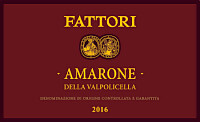
|
|
Amarone della Valpolicella Riserva 2016 |
|
| Fattori (Veneto, Italy) | |
 Corvina (65%), Corvinone (15%), Rondinella (10%), Other Grapes (10%) Corvina (65%), Corvinone (15%), Rondinella (10%), Other Grapes (10%) | |
| Price: € 48.00 | Score: |
 Intense ruby red and nuances of garnet red, little transparency. Intense ruby red and nuances of garnet red, little transparency. Intense, clean, pleasing, refined and elegant, starts with hints of
blackberry, plum, black cherry followed by aromas of dried violet,
blueberry, iris, chocolate, tobacco, cinnamon, face powder, leather,
licorice, mace, pink pepper, vanilla and menthol. Intense, clean, pleasing, refined and elegant, starts with hints of
blackberry, plum, black cherry followed by aromas of dried violet,
blueberry, iris, chocolate, tobacco, cinnamon, face powder, leather,
licorice, mace, pink pepper, vanilla and menthol.
 Properly tannic attack and however balanced by alcohol, full body,
intense flavors, pleasing roundness. Properly tannic attack and however balanced by alcohol, full body,
intense flavors, pleasing roundness.
 Very persistent finish with long flavors of blackberry, plum and black
cherry. Very persistent finish with long flavors of blackberry, plum and black
cherry.
 36 months in cask. 36 months in cask. |
|
 Game, Braised and stewed meat, Roasted meat, Hard cheese Game, Braised and stewed meat, Roasted meat, Hard cheese |
|
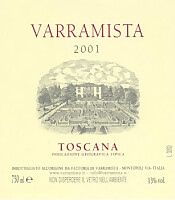
|
|
Varramista 2001 |
|
| Fattoria Varramista (Tuscany, Italy) | |
 Syrah (90%), Merlot (10%) Syrah (90%), Merlot (10%) | |
| Price: € 50.00 | Score: |
 Brilliant garnet red and nuances of garnet red, little transparency. Brilliant garnet red and nuances of garnet red, little transparency. Intense, clean, pleasing, refined and elegant, starts with hints of
black currant, plum and dried violet followed by aromas of black cherry,
blueberry, tar, cocoa, leather, licorice, tobacco, black pepper, coffee,
toffee, carob, mace, vanilla and menthol. Intense, clean, pleasing, refined and elegant, starts with hints of
black currant, plum and dried violet followed by aromas of black cherry,
blueberry, tar, cocoa, leather, licorice, tobacco, black pepper, coffee,
toffee, carob, mace, vanilla and menthol.
 Properly tannic attack and however balanced by alcohol, full body,
intense flavors, pleasing roundness. Properly tannic attack and however balanced by alcohol, full body,
intense flavors, pleasing roundness.
 Very persistent finish with long flavors of black currant, plum and
black cherry. Very persistent finish with long flavors of black currant, plum and
black cherry.
 15 months in barrique, 12 months in bottle. 15 months in barrique, 12 months in bottle. |
|
 Game, Roasted meat, Stewed and braised meat, Cheese Game, Roasted meat, Stewed and braised meat, Cheese |
|
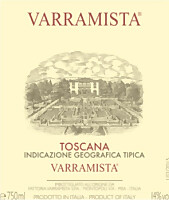
|
|
Varramista 2015 |
|
| Fattoria Varramista (Tuscany, Italy) | |
 Syrah Syrah | |
| Price: € 50.00 | Score: |
 Deep ruby red and nuances of ruby red, little transparency. Deep ruby red and nuances of ruby red, little transparency. Intense, clean, pleasing, refined and elegant, starts with hints of
black currant, black cherry and blueberry followed by aromas of violet,
plum, cocoa, black pepper, tobacco, cinnamon, mace, licorice, leather,
vanilla and eucalyptus. Intense, clean, pleasing, refined and elegant, starts with hints of
black currant, black cherry and blueberry followed by aromas of violet,
plum, cocoa, black pepper, tobacco, cinnamon, mace, licorice, leather,
vanilla and eucalyptus.
 Properly tannic attack and however balanced by alcohol, full body,
intense flavors, agreeable. Properly tannic attack and however balanced by alcohol, full body,
intense flavors, agreeable.
 Very persistent finish with long flavors of black currant, black cherry
and blueberry. Very persistent finish with long flavors of black currant, black cherry
and blueberry.
 18 months in barrique, at least 48 months in bottle. 18 months in barrique, at least 48 months in bottle. |
|
 Game, Roasted meat, Stewed and braised meat, Cheese Game, Roasted meat, Stewed and braised meat, Cheese |
|
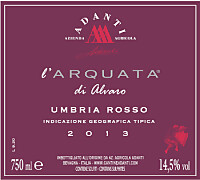
|
|
L'Arquata di Alvaro 2013 |
|
| Adanti (Umbria, Italy) | |
 Cabernet Sauvignon (40%), Merlot (40%), Barbera (20%) Cabernet Sauvignon (40%), Merlot (40%), Barbera (20%) | |
| Price: € 21.00 | Score: |
 Intense ruby red and nuances of garnet red, little transparency. Intense ruby red and nuances of garnet red, little transparency. Intense, clean, pleasing, refined and elegant, starts with hints of
plum, black cherry and black currant followed by aromas of dried violet,
blueberry, carob, tobacco, cocoa, leather, licorice, porcino mushroom,
vanilla and menthol. Intense, clean, pleasing, refined and elegant, starts with hints of
plum, black cherry and black currant followed by aromas of dried violet,
blueberry, carob, tobacco, cocoa, leather, licorice, porcino mushroom,
vanilla and menthol.
 Properly tannic attack and however balanced by alcohol, full body,
intense flavors, pleasing roundness. Properly tannic attack and however balanced by alcohol, full body,
intense flavors, pleasing roundness.
 Persistent finish with flavors of plum, black cherry and black currant. Persistent finish with flavors of plum, black cherry and black currant. 30 months in cask and barrique, 12 months in bottle. 30 months in cask and barrique, 12 months in bottle. |
|
 Game, Roasted meat, Stewed and braised meat, Hard cheese Game, Roasted meat, Stewed and braised meat, Hard cheese |
|
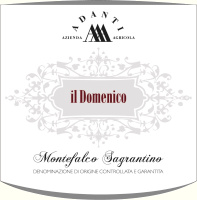
|
|
Montefalco Sagrantino Il Domenico 2008 |
|
| Adanti (Umbria, Italy) | |
 Sagrantino Sagrantino | |
| Price: € 40.00 | Score: |
 Deep ruby red and nuances of garnet red, little transparency. Deep ruby red and nuances of garnet red, little transparency. Intense, clean, pleasing, refined and elegant, starts with hints of
blackberry, plum and dried violet followed by aromas of black cherry,
blueberry, cocoa, leather, licorice, tobacco, tar, pink pepper, cinnamon,
mace, graphite, vanilla and menthol. Intense, clean, pleasing, refined and elegant, starts with hints of
blackberry, plum and dried violet followed by aromas of black cherry,
blueberry, cocoa, leather, licorice, tobacco, tar, pink pepper, cinnamon,
mace, graphite, vanilla and menthol.
 Properly tannic attack and however balanced by alcohol, full body,
intense flavors, pleasing roundness. Properly tannic attack and however balanced by alcohol, full body,
intense flavors, pleasing roundness.
 Very persistent finish with long flavors of blackberry, plum and black
cherry. Very persistent finish with long flavors of blackberry, plum and black
cherry.
 30 months in cask, 24 months in bottle. 30 months in cask, 24 months in bottle. |
|
 Game, Roasted meat, Braised and stewed meat, Hard cheese Game, Roasted meat, Braised and stewed meat, Hard cheese |
|
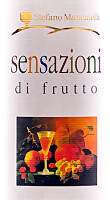
|
|
Lacrima di Morro d'Alba Sensazioni di Frutto 2019 |
|
| Stefano Mancinelli (Marches, Italy) | |
 Lacrima Lacrima | |
| Price: € 10.00 | Score: |
 Deep ruby red and nuances of purple red, little transparency. Deep ruby red and nuances of purple red, little transparency. Intense, clean, pleasing and refined, starts with hints of blackberry,
black cherry and rose followed by aromas of violet, strawberry, raspberry,
pomegranate, plum, blueberry and cyclamen. Intense, clean, pleasing and refined, starts with hints of blackberry,
black cherry and rose followed by aromas of violet, strawberry, raspberry,
pomegranate, plum, blueberry and cyclamen.
 Properly tannic attack and however balanced by alcohol, good body,
intense flavors, pleasing crispness. Properly tannic attack and however balanced by alcohol, good body,
intense flavors, pleasing crispness.
 Persistent finish with flavors of blackberry, black cherry and
raspberry. Persistent finish with flavors of blackberry, black cherry and
raspberry.
 Produced with carbonic maceration. Produced with carbonic maceration. |
|
 Pasta with meat and mushrooms, Sauteed meat with mushrooms Pasta with meat and mushrooms, Sauteed meat with mushrooms |
|
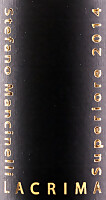
|
|
Lacrima di Morro d'Alba Superiore 2018 |
|
| Stefano Mancinelli (Marches, Italy) | |
 Lacrima Lacrima | |
| Price: € 14.50 | Score: |
 Intense ruby red and nuances of purple red, little transparency. Intense ruby red and nuances of purple red, little transparency. Intense, clean, pleasing, refined and elegant, starts with hints of
rose, blackberry and black cherry followed by aromas of strawberry, plum,
violet, blueberry, carob, face powder, black pepper, vanilla and menthol. Intense, clean, pleasing, refined and elegant, starts with hints of
rose, blackberry and black cherry followed by aromas of strawberry, plum,
violet, blueberry, carob, face powder, black pepper, vanilla and menthol.
 Properly tannic attack and however balanced by alcohol, good body,
intense flavors, pleasing crispness. Properly tannic attack and however balanced by alcohol, good body,
intense flavors, pleasing crispness.
 Persistent finish with flavors of rose jam, blackberry and black
cherry. Persistent finish with flavors of rose jam, blackberry and black
cherry.
 12 months in cask and barrique, 3 months in bottle. 12 months in cask and barrique, 3 months in bottle. |
|
 Stuffed pasta with mushrooms, Stewed meat with mushrooms, Broiled meat Stuffed pasta with mushrooms, Stewed meat with mushrooms, Broiled meat |
|
|
||||||||
|
DiWineTaste Polls
|
| |||||||
Privacy Policy | |||||||


| Copyright © 2002-2024 Antonello Biancalana, DiWineTaste - All rights reserved |
| All rights reserved under international copyright conventions. No part of this publication and of this WEB site may be
reproduced or utilized in any form or by any means, electronic or mechanical, without permission in writing from DiWineTaste. |